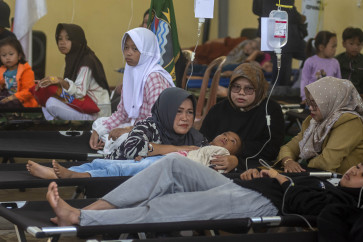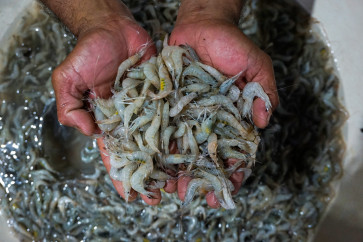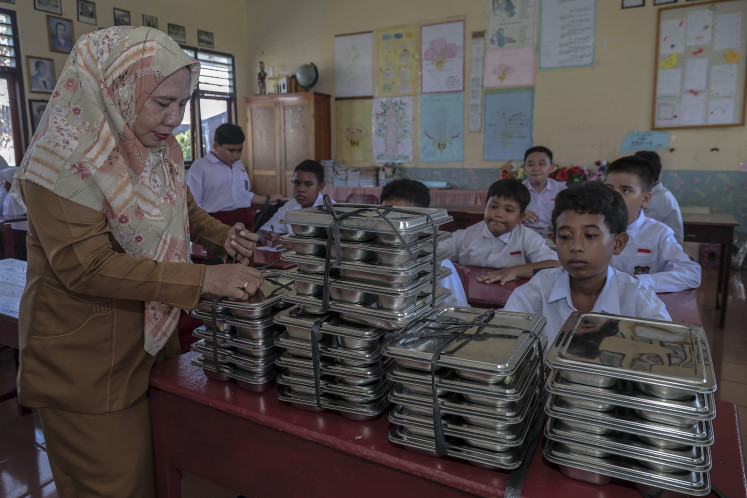Popular Reads
Top Results
Can't find what you're looking for?
View all search resultsPopular Reads
Top Results
Can't find what you're looking for?
View all search resultsJenang Festival, preserving Solo’s culinary heritage
National symbol: Red-and-white jenang is synonymous with the Jenang Festival in Solo, the cultural name of Surakarta, Central Java
Change text size
Gift Premium Articles
to Anyone
N
span class="caption" style="width: 339px;">National symbol: Red-and-white jenang is synonymous with the Jenang Festival in Solo, the cultural name of Surakarta, Central Java. In the Javanese tradition, jenang is considered closely related to the phases of life, from conception to demise. Made mostly from rice or sticky rice, brown sugar and coconut milk, this Javanese porridge or pudding is more than just a snack and always present as an element in rituals.
However, many Javanese people today are unaware of the traditional significance of jenang, apart from its usual consumption as a snack. It is even seen as an old-fashioned food only fit for infants or invalids. “Javanese people’s connection with jenang is being forgotten. They mostly see it as food for the sick. So the Javanese public should be reminded of its traditional value,” said Javanese cultural observer Ronggojati Sugiyatno.
The Jenang Festival, held in the area of Ngarsopuro, Surakarta (Solo), Central Java, on Feb. 17, was also inspired by the spirit of reviving jenang as Solo’s culinary heritage and typical snack. As part of the 268th anniversary celebration of the city, the second festival displayed 150 kinds of jenang in numerous kendil (earthen pots) and pincuk (folded banana leaves).
Ready to serve: Stallholders tend their jenang stalls.
From morning, thousands of residents flocked to Ngarsopuro, south of Mangkunegaran Palace. Assorted jenang prepared in different styles including sumsum (with rice flour), gendul (with brown sugar), mutiara (in bead form) and merah-hitam (with black sticky rice), filled the pots in bamboo stalls. Those presenting the food were clad in traditional costumes.
Solo Mayor FX Hadi “Rudy” Rudyatmo opened the festival by striking a wooden gong. Procession participants carried dozens of bamboo trays with red-and-white jenang. On the left lane of Ngarsopuro, bamboo jenang stalls stood in rows. Rudy poured water into a brass pan to signal the start of the parade. A royal troop from the Surakarta Palace, dozens of dancers and hundreds of students marched behind.
Like the good old days: An elderly lady savors jenang served in pincuk (folded banana leaves). “Red-and-white jenang symbolizes the existence of people in the world. The red represents male and the white female. As the masculine and the feminine combine, they bring forth humans to the world,” explained festival organizer Slamet Rahardjo. Ronggojati also referred to the inseparability of jenang from Javanese culture and beliefs. Thanksgiving ceremonies held by Javanese families have always included jenang in their offerings, such as the ritual for a Javanese woman marking the seven-months of pregnancy called mitoni. When her child is born, another thanksgiving is held with jenang.
The event displayed the special jenang for pregnant mothers, comprising baning (for the first month), iber-iber (second month), and procot (ninth month). All these versions for pregnancy generally signify an expression of gratitude.
For the first-month pregnancy, according to Slamet, baning is prepared, meaning the unification of red and white. For the second month, iber-iber symbolizes a search or pursuit. It is made from the best rice flour with coconut milk and
juruh (liquid brown sugar).
Javanese smiles: Wearing traditional costumes, several women participate in a parade, as part of the festival.
Finally, for the ninth month getting ready for the child’s birth, procot is served in the form of white jenang mixed with bananas, and a prayer is offered for a safe delivery.
The one-time spiritual adviser of Surakarta King Paku Buwono XII said the meaning of jenang could differ on various occasions. Red jenang for a woman soon after child birth, for instance, signifies the restoration of strength, while its white counterpart or sumsum represents sincerity and virtue.
Apart from local jenang, imported products were also featured in this year’s festival including those from Japan, China and Korea, which attracted visitors’ attention. “I was curious at first. But what they call Chinese jenang turns out to be kue keranjang [lunar new year cake]. It’s very sweet and sticky,” said Niken Ariani, a visitor.
Diversity: Dancers and performers enliven the Jenang Festival held recently in Ngarsopuro, Solo, Central Java.
Spectators could indeed sample jenang for free. At least 15,000 portions in folded banana leaves were provided for them. So as soon as the mayor struck the gong, people crowded the bamboo stalls, although a few had ventured to grab the food before the official kickoff. Thereafter, most of them savored the festival food on sidewalks by using leaf spoons.
“This festival is one way of preserving jenang by Solo residents, as a complement to ritual ceremonies and a traditional food. With the passage of time, jenang is being overlooked. While it used to be indispensable at birthday parties, now it has been replaced by tarts,” said Rudy.
Rudy indicated that red-and-white jenang had always accompanied Javanese rituals as a reflection of the unity of two opposite elements to generate a force of security. “It has become the central part of Solo’s anniversary commemoration for the wellbeing of the city. More than just a festival, it serves to remind us of the jenang philosophy,” he said.
The old guard: Surakarta public order officers on parade at the festival.
“With its sweet taste and appetizing flavor, jenang implies welfare. Formerly, sugar and coconut milk were not cheap. The sticky texture of this food is taken to denote unity and integrity,” said Ronggojati.
Slamet further noted that in terms of traditional culinary nutrients jenang had long been consumed for breakfast for its carbohydrate, sugar and protein in balanced amounts, as a good energy source. “It’s also soft, good for the stomach and intestines in the morning.”
In many cities jenang has become increasingly rare. But in Solo, it is still available not only in the corners of traditional markets but also in several areas of the city like Baluwarti, Pasar Kliwon, Sriwedari and Keprabon.
“I would love to see such local culinary products as jenang enter star-rated hotels. Local food actually is not inferior in quality to foreign cooking. Jenang may need attractive packaging in order to be included in hotel menus. There should be a new breakthrough to boost the development of traditional culinary specialties,” added Rudy.
— Photos by JP/Ganug Nugroho Adi















